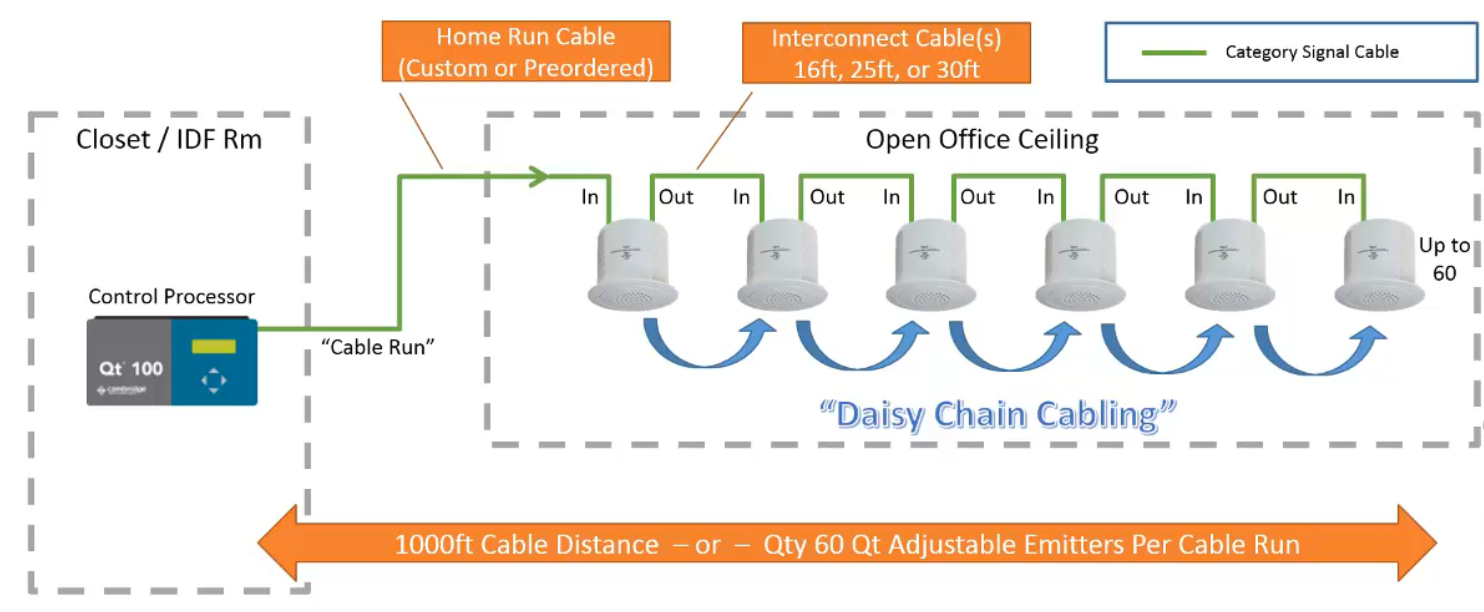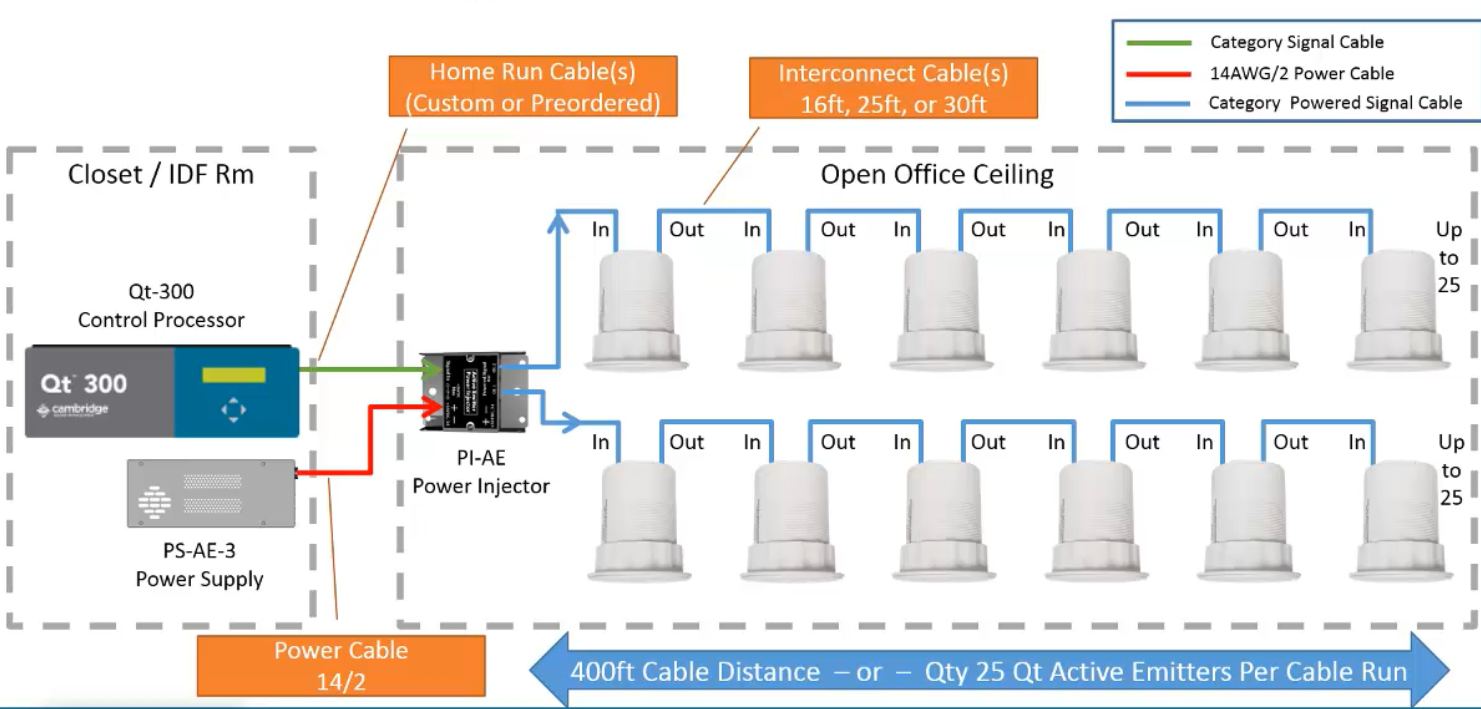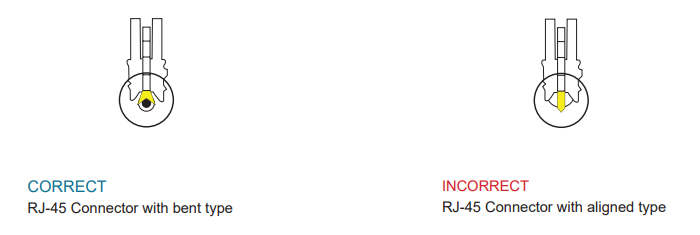QtPro hardware and distance limitations
This article describes the hardware limitations and maximum cabling distances in Cambridge Qt sound masking systems. It includes hardware limitations for different control modules, distance limitations for the different types of sound masking emitters (standard and active), and guidelines for custom cabling.
Control Module hardware limitations
Qt 100 Control Modules
Qt 100 controllers support one zone, and have a maximum emitter count of 120 standard emitters . Qt 100 modules have two outputs, Run 1 and Run 2. All emitters on Run 1 and Run 2 are controlled equally. Each run has a maximum of 60 standard emitters and each run supports a maximum cable length of 1000ft from the control processor to the farthest emitter. (Max emitter count or Max cable distance - whichever comes first)
Note: Qt 100 control modules do not support active emitters.
Qt 300/600 Control Modules
Both Qt 300 and Qt 600 controllers support the same number of emitters per zone. The only difference between the two controllers is the amount of zones they support, with the Qt 300 supporting up to 3 zones and the Qt 600 supporting up to 6 zones. For standard emitters, the Qt 300/600 has a maximum emitter count of 120 standard emitters per zone . Each zone has two identical outputs, Run 1 and Run 2. Each run has a maximum of 60 standard emitters.
For active emitter products, these require the addition of our PS-AE-3 Qt® Active Emitter Power Supply (3-Zone Power Supply) and the PI-AE Qt® Active Emitter Power Injector (which combines power & the audio signal to each string of emitters. The PI-AE Only powers a maximum of 50 emitters on the same Zone, with 25 emitters on zone Run 1, and 25 emitters on Run 2.
Note: All emitters on must be the same type per zone (either standard or active).
Distance limitations and cabling overview
A single cable run of emitters (from control module to last emitter) can be up to 1,000 ft of cable for standard emitters and 800 ft for active emitters. Additional limitations for type of emitter are explained below.
When the total cable length becomes too lengthy, there will typically be a drop in masking level or volume level across the run. There is no limit to the length of cable between two speakers; however, it is not recommended to use a large number of custom length cables.
Qt Standard Emitters 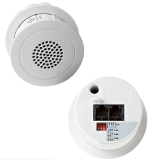
Sometimes also referred to as adjustable emitters, these are a passive audio loudspeaker device suitable for sound masking and limited output level paging applications. This emitter receives an amplified signal directly from the Qt Pro control module via a UTP category cabling infrastructure.
Standard emitters have a cabling distance limitation of 1000 ft from control module to the farthest emitter. This applies to all types of control modules.
Qt Active Emitters
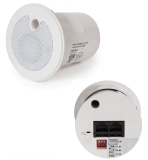 An active (self-powered) audio loudspeaker device is suitable for sound masking as well as paging/ background music environments. This emitter contains an internal amplifier which receives the audio signal directly from the Qt Pro control module in addition to a direct current voltage which powers the Qt Active Emitter device. Both power supply(s) and voltage injectors are required for operation in addition to the Qt Pro control module.
An active (self-powered) audio loudspeaker device is suitable for sound masking as well as paging/ background music environments. This emitter contains an internal amplifier which receives the audio signal directly from the Qt Pro control module in addition to a direct current voltage which powers the Qt Active Emitter device. Both power supply(s) and voltage injectors are required for operation in addition to the Qt Pro control module.
Active emitters have a cabling distance limitation of 600 ft from Qt Pro controller to injector, and 400 ft from power injector to farthest emitter. Power cable distance limitation is 400 ft from PS-AE-3 power supply to PI-AE injector using 14/2 conductor cable.
Custom cabling guidelines
Each job-made cable should be manufactured according to ANSI/TIA/EIA Standard 568-B, and should be tested with a LAN cable tester before installation.
Important considerations
- Use solid conductor 24 AWG CAT-3 cable that meets local code requirements
- If the system is installed in a return air plenum, the cable must be plenum rated
- Shielding is not required. Unshielded twisted pair (UTP) cable is acceptable.
- Snagless boots are not required.
- RJ-45 plugs must use the "bent 3-tine" RJ-45 plugs intended for use with solid core CAT wire. Three-tine plugs can be purchased at a hardware store and from most CAT cable suppliers. DO NOT USE the "aligned two-tine" type intended for stranded wire, as they provide improper contact and may yield intermittent system operation. The diagram below shows the cross section view of both types.


